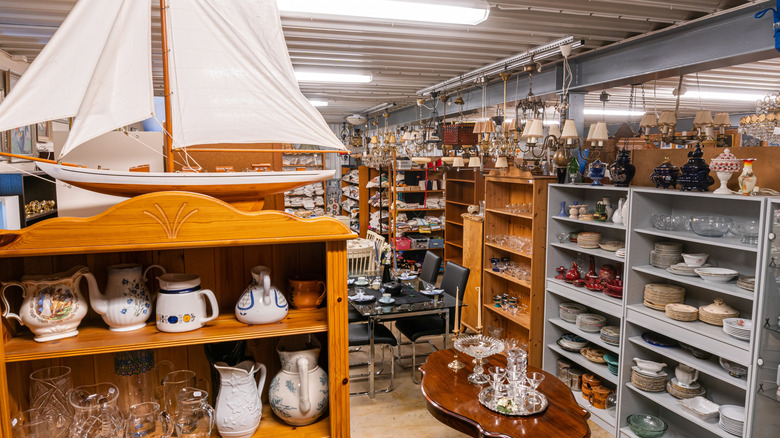The Rare Vintage Kitchen Oddity You'd Be Extremely Lucky To Find At A Thrift Store
Unique serving pieces can be a beautiful way to decorate your kitchen or wow at your next gathering. This is especially true if you are using vintage pieces, which offer not only unique style, but a sense of charm that only comes with retro décor. Thrifted vintage ceramics come in a host of varieties. Some are made by famous pottery companies or vintage dishware brands like Roseville or Hull Pottery, while others have a more personal touch, created by individual ceramicists. This can mean that these older pieces are even rarer and more in demand. One such rare vintage kitchen oddity is a Christmas tree-shaped deviled egg tiered tray. These serving trees are a rarity to look out for when thrifting. Not only do they offer a cute and whimsical way to serve deviled eggs, but they can be worth a lot when resold to collectors or vintage ceramics enthusiasts.
In addition to being functional for holding a lot of eggs, these trees can add vintage charm to a holiday table or buffet spread. You can occasionally find vintage ones in online auctions, estate sales, and antique markets, but they are likely to cost you at least $100 depending on condition. Some contemporary ceramicists also make new ones from the original Duncan mold, fetching upwards of $400 on marketplaces like Etsy.
More about vintage deviled egg trees
The original Duncan mold was created by Duncan Enterprises, a company started by ceramic artist Erma Duncan in 1946, which began to design unique ceramic items for décor and everyday use. While the company was later acquired by Mayco, there is no indication they sell molds with this design today. This means the mold itself can be quite a rarity if you work in ceramics.
The finished product is composed of three layers of glazed ceramic pieces, designed to stack on top of each other, and offering room for up to 36 eggs. Usually created with tree-green glazing, you can occasionally find them in white or pale green. They are similar in style to the ubiquitous vintage light-up ceramic trees popular in the latter half of the 20th century, most of which have the same stackable construction. Some trees, like many ceramic pieces made by artisans, will likely have details on the bottom from the artist, like names and dates, which can help you determine age and origin. Other details like wear, chips, and scratches can also help determine if it's a vintage creation or a newer piece made from an old mold.
If you manage to find one of these gems, it makes a chic holiday centerpiece idea, or a fun and festive container for things like jewelry, buttons, or paper clips. Or, add some small ball ornaments to each indent. Alternatively, this ArtsAndCoStore vintage treat tree on Etsy has a similar look, but can hold more things in different shapes.
